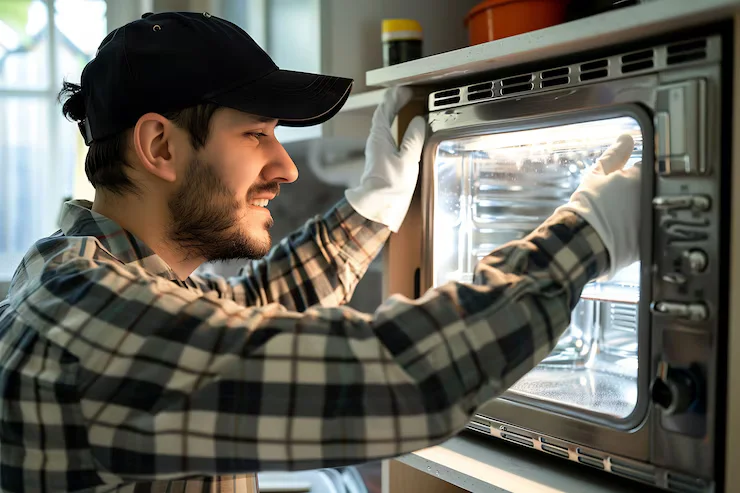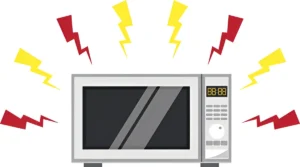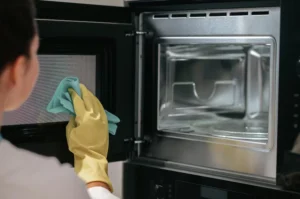
By Admin
Microwave is not heating food evenly? Learn the real reasons and repair tips shared by experts from a reputed microwave repair service.
You pop in leftovers, hit start, and expect steaming hot food. But instead, one side is cold while the other is bubbling like lava. Sound familiar? If your microwave is not heating food evenly, you’re not alone.
This is one of the most common problems people face with microwaves, whether it’s an entry-level model or a high-end smart appliance. But uneven heating isn’t always a sign your microwave is broken. It could be a sign of wear, improper use, or specific internal issues that need addressing.
Let’s break down why this happens and how you can fix or prevent it, step by step.
To understand why it doesn’t heat evenly, you first need to know how it’s supposed to work.
A microwave uses electromagnetic radiation to excite water molecules in food, generating heat from the inside out. Ideally, the microwave energy should distribute evenly so that your meal is uniformly heated.
But in real-world use, several internal or external factors can interfere with that process.

Placing food in the center of the turntable may seem logical, but that’s not always best. Microwaves often have hot spots, and placing your dish slightly off-center can help it rotate through these zones more effectively.
If the turntable doesn’t spin, your food stays in one spot and receives uneven microwave exposure. A broken motor or misaligned turntable could be the culprit.
The magnetron is what produces the actual microwave energy. If it’s aging or malfunctioning, the waves may not be generated consistently, causing heating inconsistencies.
The waveguide channels energy from the magnetron into the cooking chamber. If it’s dirty, blocked, or damaged, the waves may not spread out properly. Similarly, stirrer fans (found in some models) help distribute waves evenly. If stuck, uneven heating can occur.
Metallic containers or thick plastic bowls may not allow microwave energy to pass through evenly. Always use microwave-safe glass or ceramic to promote uniform heating.
Stuffing in large portions or multiple dishes at once can prevent proper circulation of microwave energy, leading to hot and cold zones.
Grease or condensation buildup on the cavity walls or waveguide can obstruct the microwave’s internal operation, reducing its efficiency.

If your microwave is not heating as it should, here’s a systematic way to diagnose the issue:
Rotate the dish manually to check for turntable motor function
Test with a cup of water to see if it heats uniformly
Try different cookware (use only microwave-safe containers)
Inspect the door seal—damaged seals can leak energy
Check for error codes (refer to the model’s manual)
If none of these solve the issue, the problem could be internal, requiring expert inspection.
You might think uneven heating is just a minor annoyance. But over time, it can:
Damage sensitive electronics inside the unit
Lead to undercooked or unsafe food
Cause energy waste due to prolonged heating cycles
Increase the risk of electrical issues or overheating
In extreme cases, microwave inefficiencies can be a safety hazard. That’s why identifying and fixing the issue promptly is essential.
Stir halfway through heating to even out temperature
Use round dishes, not square ones—they promote better energy flow
Clean the interior after every few uses to remove moisture or residue
Avoid center placement—offset dishes for better exposure
Try power cycling your microwave (unplug for 10 mins)
If these don’t work, professional diagnosis is your best bet—especially if you’re dealing with an old or commercial-grade microwave.
Food is still cold even after extended heating
Microwave makes strange noises during operation
The unit gives off a burnt smell or sparks
You’ve already replaced the turntable or fuse, but issues persist
In such cases, seeking a reputed microwave repair services can save time, money, and risk.

Q1. Can a microwave work even if the magnetron is damaged?
Sometimes, yes. You might still see the light turn on and hear it running, but heating won’t occur—or it’ll be uneven.
Q2. Is it dangerous to keep using a microwave that heats unevenly?
Yes. Besides food safety issues, damaged internal parts may lead to overheating or electrical faults.
Q3. Does uneven heating mean I need a new microwave?
Not always. Many issues can be fixed with part replacements or realignment. Only replace the unit if repair cost exceeds 50% of its value.
Q4. How often should a microwave be serviced?
Regular cleaning is essential, but for internal check-ups, consider a professional service every 12–18 months.
Q5. Can I repair a microwave myself if it’s not heating properly?
DIY cleaning or checking the turntable is fine. But for electrical or magnetron issues, always consult a trained technician.
Use microwave-safe, round cookware
Don’t place food directly in the center
Avoid overloading with multiple dishes
Keep your microwave clean and dry inside
Stir or rotate food halfway through heating
Schedule periodic professional check-ups
When it comes to appliance repair, particularly for devices that deal with heat and electricity, experience and training matter. Skilled professionals not only solve the problem but ensure your appliance is functioning safely and efficiently.
Some services specialize specifically in microwave diagnostics, part replacement, and safety calibration, offering both home and commercial repair services. These providers help households avoid the cost of replacement and the frustration of inefficient appliances.
If your microwave is not heating food evenly, it’s more than an inconvenience—it’s a warning sign. While small fixes can sometimes help, persistent issues often indicate internal problems that need expert care.
Understanding what’s going wrong and taking proactive steps can extend your microwave’s life, improve energy efficiency, and keep your food safe.
And when expert attention is needed, always turn to trusted, experienced technicians—those who combine know-how with transparency.